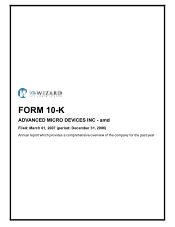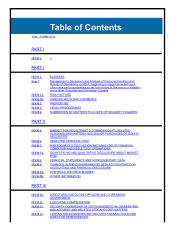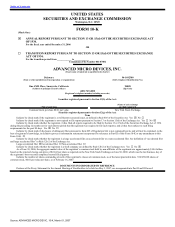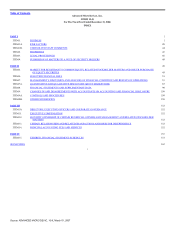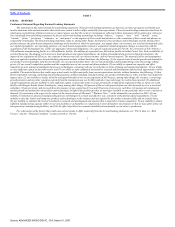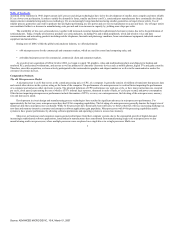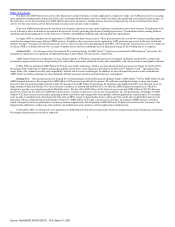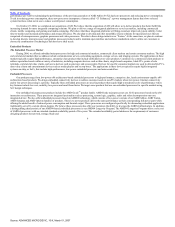AMD 2006 Annual Report Download - page 10
Download and view the complete annual report
Please find page 10 of the 2006 AMD annual report below. You can navigate through the pages in the report by either clicking on the pages listed below, or by using the keyword search tool below to find specific information within the annual report.
Table of Contents
Our dual-core AMD Opteron processors offer improved overall performance on many applications compared to single-core AMD processors by executing
more operations simultaneously during each clock cycle, and improved performance-per-watt, which can reduce the operational costs related to power usage. At
the same time, servers based on dual-core AMD Opteron processors are easier to manage because more processing capacity can be concentrated into fewer
servers. For the same reason, servers based on dual-core processors are less costly to operate.
Dual-core AMD Opteron processors also allow our enterprise customers to more easily implement virtualization across their business. Virtualization is the
use of software to allow workloads to be shared at the processor level by providing the illusion of multiple processors. Virtualization enables running different
operating systems and applications on the same server, thereby consolidating workloads and reducing hardware requirements.
In August 2006 we introduced a new generation of AMD Opteron dual-core processors. These processors provide several new features including improved
virtualization support and energy efficient DDR2 memory. In addition, these processors can be replaced by AMD quad-core processors in the same socket and
thermal envelope. Our quad-core x86 processors for servers, which we expect to begin shipping in mid-2007, will incorporate four processor cores on a single die
of silicon. DDR2, or double data rate two, is a type of random access memory technology used for high speed storage of the working data of a computer.
Notebook PCs. Our microprocessors for notebook PCs consist primarily of AMD Turion ™ 64 processors and mobile AMD Sempron™ processors. We
designed our mobile processor products for high-performance, longer battery life and wireless connectivity.
AMD Turion 64 processors represent our most advanced family of Windows-compatible processors for thinner and lighter notebook PCs, and provide
performance improvements such as longer battery life, reduced heat generation, enhanced security and compatibility with current wireless and graphics solutions.
In May 2006 we introduced AMD Turion 64 X2 dual-core mobile technology, which is our most advanced dual-core processor family for notebook PCs.
We designed this technology to enable leading-edge graphics for the more visual experience provided by the Microsoft® Windows Vista ™ operating system,
longer battery life, enhanced security and compatibility with the latest wireless technologies. In addition, we have designed the process used to manufacture
AMD Turion 64 mobile technology for more thermally efficient processor operation and reduced power consumption.
Desktop PCs. Our microprocessors for desktop PCs consist primarily of the following tiered product brands: AMD Athlon ™ 64 FX, AMD Athlon 64 and
AMD Sempron processors. We designed the AMD Athlon 64 FX processor specifically for gamers, PC enthusiasts and digital content creators who require
processors that can perform graphic-intensive tasks. We designed our AMD Athlon 64 processors for enterprises and sophisticated PC users that seek to access
large amounts of data and memory. For value-conscious consumers of desktop and notebook PCs, we offer the AMD Sempron microprocessor, which we
designed to provide core computing needs at affordable prices. We also offer AMD Athlon 64 X2 dual-core processors and AMD Athlon 64 FX X2 dual-core
processors, which like the dual-core AMD Opteron processors, contain two processor cores on one semiconductor die. The performance advantages of AMD
Athlon 64 X2 dual-core processors enable operating systems to prioritize and manage tasks from multiple software applications simultaneously. For example,
users are able to simultaneously download audio files such as MP3s, record to digital media devices, check and write email, edit a digital photo and run virus
protection without compromising the performance of their PC. AMD Athlon 64 X2 dual-core processors also have an integrated DDR2 memory controller,
which is designed to increase performance on memory-intensive applications. We designed the AMD Athlon 64 X2 dual-core processors for “prosumer” and
digital media enthusiasts or other users who routinely run multiple processor-intensive software applications simultaneously.
In December 2006, we introduced a new generation of AMD Athlon 64 X2 dual-core processors which are manufactured using 65-nanometer technology.
We designed these processors to deliver improved
5
Source: ADVANCED MICRO DEVIC, 10-K, March 01, 2007

